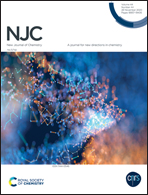Utilising anatase nano-seeds coupled with a visible-light antennae system (Cu–Pd–N) for effective photo-organic transformations†
Abstract
A Cu and Pd bi-metallic surface loading strategy with nitrogen functionalisation (Cu/Pd and N) on a sol–gel prepared metal oxide (titanium dioxide, Cu/Pd–N–TiO2) has afforded a novel method to attenuate the restriction of titanium dioxide's inherent ultraviolet light activation. The functionalisation strategy (Cu, Pd, and N) has provided the opportunity to facilitate the oxidation of nine cyclic alcohols with fair to excellent conversions (39 to ≥99%). In-depth photo-physical studies using spectroscopic, microscopic and powder X-ray diffraction techniques were utilised to characterise defect-free nano-seeds of titanium dioxide (anatase). Trace surface loadings of nanomaterial copper (as copper oxide) and metallic palladium species were detected at 0.04 wt% and 0.18 wt%, respectively. These nanoparticles induced a red-shift in titanium dioxide's optical band gap towards the visible region (>440 nm).



 Please wait while we load your content...
Please wait while we load your content...